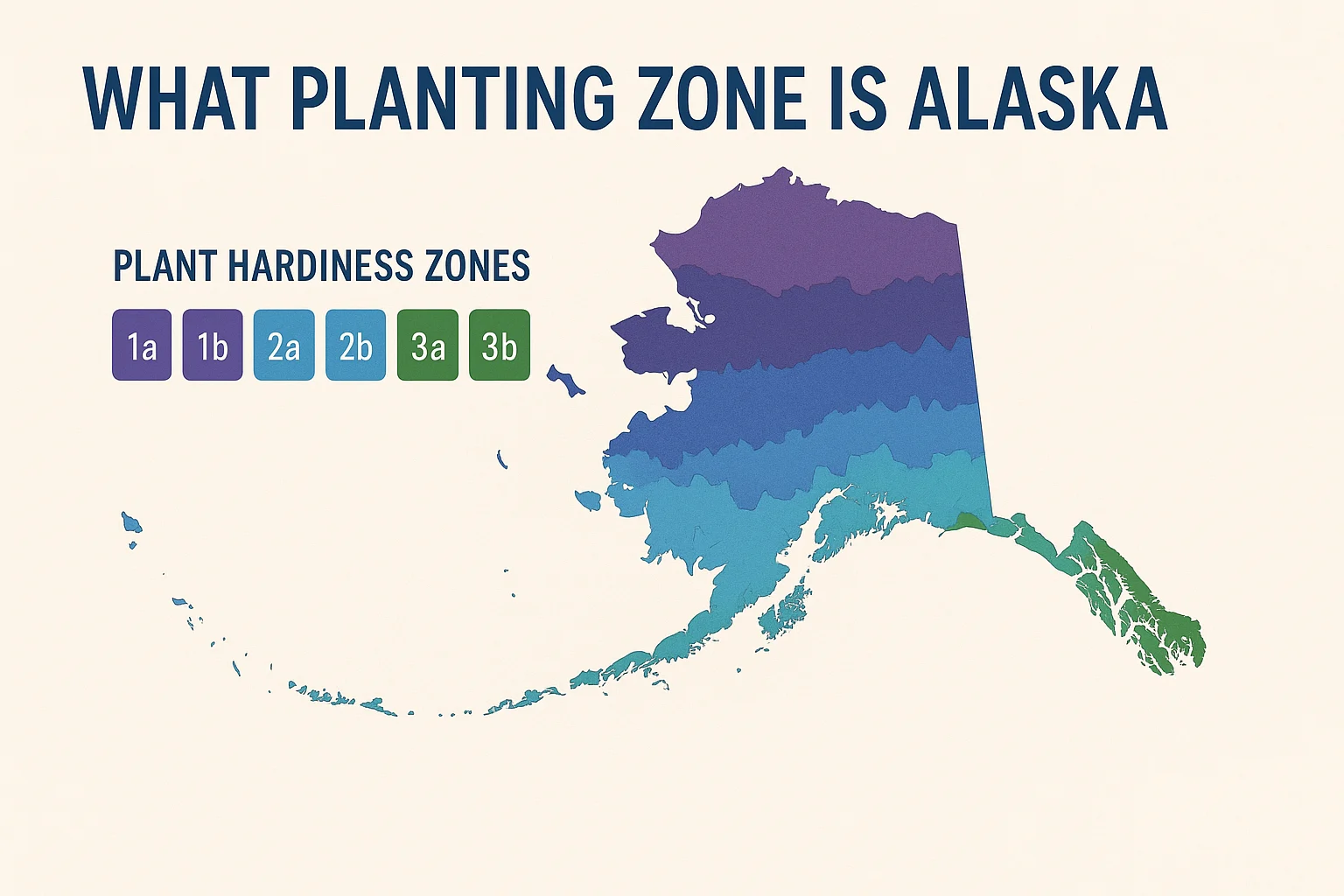What Planting Zone is Alaska?[Map, Cities, and Growing Tips]

What Planting Zone is Alaska? When it comes to gardening or landscaping in Alaska, one of the first things you need to know is your USDA Plant Hardiness Zone — also known as a planting zone. This simple number (or letter-number combo) helps you choose plants that will actually survive and thrive where you live. But what planting zone is Alabama, exactly?
In this guide, we’ll break it down by region, explain how the zones affect your plant choices, and give you real-world tips on growing successfully in Alabama’s varied climate.
🧭 What Planting Zone is Alaska?
Alaska spans an enormous range of latitudes and elevations, which means its planting zones range from Zone 1a to Zone 7b — making it home to some of the coldest gardening zones in the U.S..
| Region | USDA Zone |
|---|---|
| Interior (Fairbanks, Tok) | Zone 2a to 3b |
| Southcentral (Anchorage, Palmer, Wasilla) | Zone 4a to 5b |
| Southeast (Juneau, Sitka, Ketchikan) | Zone 6a to 7b |
| Arctic/Remote North (Barrow/Utqiaġvik) | Zone 1a to 2a |
The further south and closer to the coast you are, the milder the winters and the higher your zone. If you live in Southeast Alaska, you’re in one of the few places in the state where the zone climbs as high as 7b — comparable to parts of the Lower 48!
📍 Alaska Planting Zones by City
| City | Planting Zone |
|---|---|
| Anchorage | Zone 4b–5a |
| Fairbanks | Zone 2b–3a |
| Juneau | Zone 6a–7a |
| Ketchikan | Zone 7a–7b |
| Wasilla | Zone 4a–4b |
| Sitka | Zone 7a |
| Nome | Zone 2a |
| Barrow | Zone 1a |
| Homer | Zone 6a |
Remember, these zones are based on average annual minimum winter temperatures, so your actual conditions may vary depending on elevation, wind exposure, and whether you live in a valley or on a hill.
❄️ Why Planting Zones Matter So Much in Alaska?
Alaska’s growing season is short. Many areas get only 80 to 120 frost-free days, which means the zone you live in directly determines:
- Which perennial plants can survive the winter
- How early you can start planting in spring
- Whether you’ll need season extenders like greenhouses or row covers
- If you should start seeds indoors (hint: yes, almost always)
If you live in Zone 2 or 3, many common flowers and vegetables simply won’t make it unless you treat them as annuals or start them indoors. Meanwhile, gardeners in Juneau or Sitka (Zones 6–7) can experiment with a much wider variety of plants.
📆 Alaska’s Short But Intense Growing Season
Here’s a general planting guide based on Alaska’s planting zones:
| Crop Type | Zone 2–3 Start | Zone 4–5 Start | Zone 6–7 Start |
|---|---|---|---|
| Cool-weather (lettuce, spinach) | Early June | Late May | Mid-May |
| Warm-weather (tomatoes, beans) | Early July (in greenhouse) | Late May/early June | Late May |
| Perennials | Early June (most die back in winter) | May | April or early May |
Most vegetables in Alaska are grown from transplants, not seeds — especially tomatoes, peppers, and herbs. Many gardeners start seeds in February or March indoors, then transplant in late May or June after the last frost.
💡 How to Garden Successfully in Alaska’s Zones?
Despite the cold winters, Alaska has a few tricks up its sleeve:
🌞 Extended Daylight = Fast Growth
In summer, some areas of Alaska receive up to 22 hours of sunlight per day. This triggers explosive growth in leafy greens, root crops, and flowers — but only if you plant early and wisely.
🏡 Use Season Extenders
To maximize growing time:
- Use cold frames or high tunnels
- Build a hoop house
- Cover raised beds with clear plastic in May
- Invest in a small greenhouse if possible
🪴 Start Indoors
Even in warmer parts of Alaska, indoor seed starting is essential. Use grow lights, heating mats, and seed trays in February–April.
🔥 Real Example: Carrots in Zone 3 vs. Zone 6
In Zone 3 (Fairbanks), you may need to pre-warm the soil with black plastic and plant carrots in early June, harvesting by mid-September.
In Zone 6 (Sitka), you could plant carrots outdoors by early May and harvest into October — giving you a longer and more flexible window for cool-weather crops.
📍 Want to Know Your Exact Zone?
If you’re unsure about your planting zone in Alaska, use your zip code in the official USDA Plant Hardiness Zone Map. That’s the most precise way to figure out what plants are best for your area — whether you’re in a coastal rainforest or a wind-blasted tundra town.
🧮 Useful Tools for Alaska Gardeners
Alaska gardening isn’t easy, but the right tools help:
- Soil Volume Calculator – Estimate how much soil your raised beds or containers need.
- Plant Spacing Calculator – Plan the most efficient layout, even in small hoop houses.
- Indoor Plant Watering Calculator – Perfect for indoor seedlings and overwintered plants.
🙋 Frequently Asked Questions
Can I grow vegetables in Zone 2 or 3?
Yes — with a greenhouse, row cover, or by choosing fast-growing, cold-tolerant crops like kale, spinach, radishes, and certain potatoes. You’ll need to start seeds indoors.
Can I grow fruit trees in Alaska?
Only in the warmest zones (6–7) and with hardy varieties like Norland apples, cherries, or plums. In colder zones, try dwarf varieties in containers you can move or overwinter.
When is the last frost in Alaska?
- Zone 2: Mid-June
- Zone 4–5: Late May to early June
- Zone 6–7: Early to mid-May
🌿 Final Thoughts: Understanding Alaska’s Planting Zones
Alaska’s gardening zones may sound extreme, but that doesn’t mean you can’t grow vibrant, productive gardens. Whether you’re in the mild southeast or the frozen interior, knowing your planting zone helps you choose the right plants, use the right tools, and time your planting perfectly.
So before you sow a single seed, ask:
What planting zone am I in?
Because in Alaska, that one number can mean the difference between failure and a flourishing garden.
